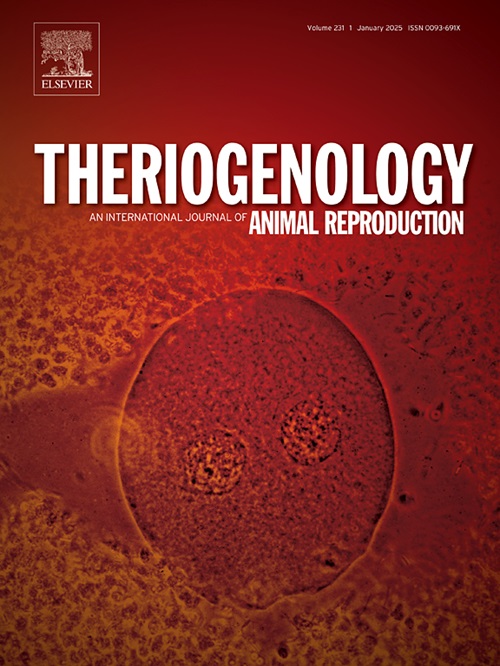多实验室环境下牛精子浓度分析的标准化
IF 2.5
2区 农林科学
Q3 REPRODUCTIVE BIOLOGY
引用次数: 0
摘要
精子浓度评估是精液分析的基本组成部分,其结果对临床管理和辅助生殖精液的制备至关重要。然而,精子浓度测量在实验室内部和实验室之间存在显著差异。本研究的目的是评估在多实验室环境下公牛精子浓度分析标准化的有效性。在实验1中,核计数器校准(27个单位,7个实验室)使用冷冻参考标准品进行评估,每个实验室的同一技术人员在12周内每周分析一次。核计数器的性能令人满意,列维-詹宁斯图表上标记的少数数据点似乎是由技术人员引入的系统错误造成的。技师内部变异系数(CV)为2.2±1.8% (mean±SD),设备内部变异系数(CV)为4.0±1.3%。实验二在6个实验室中评估了定制化电子学习培训的效果。与训练前获得的结果相比,重复结果的CV(3.2±3.8%)和重复结果差异超过10%(8.1%)的样本比例下降(P <;0.05),分别为(3.0±3.2%和6.9%)。实验三,生产10批冷冻精液,每批3个重复,编码不同。精子浓度由6个实验室的9名技术人员在一年多的时间里进行了3次测试。技师内CV为3.4±3.1%,批内CV为4.6±2.2%。Bland-Altman图显示,在所有测试期间,个体结果与总体平均值的平均差异接近于零(17 × 106精子/mL标准为-0.36至0.55 × 106精子/mL, 150 × 106精子/mL标准为-2.2至3.5 × 106精子/mL)。总之,合格的技术人员使用标准化程序和核计数器获得了精确和准确的精子浓度结果。本文章由计算机程序翻译,如有差异,请以英文原文为准。
Standardization of bovine sperm concentration analysis in a multi-laboratory setting
Sperm concentration evaluation is a fundamental component of semen analysis, as results are critical for clinical management and preparation of semen for assisted reproduction. However, significant variations in sperm concentration measurements have been reported within and across laboratories. The objective of this study was to assess the effectiveness of standardization of bull sperm concentration analysis in a multi-laboratory setting. In Experiment I, NucleoCounter calibration (27 units, seven laboratories) was evaluated using frozen reference standards analyzed weekly over 12 weeks by the same technician in each laboratory. NucleoCounter performance was satisfactory and the few data points flagged on Levey-Jennings charts seemed to result from systemic errors introduced by the technician. The intra-technician coefficient of variation (CV) was 2.2 ± 1.8 % (mean ± SD), while the intra-equipment CV was 4.0 ± 1.3 %. In Experiment II, the effect of customized e-learning training was evaluated across six laboratories. When compared to results obtained before training, CV for duplicate results (3.2 ± 3.8 %) and proportion of samples with duplicate results differing by more than 10 % (8.1 %) decreased (P < 0.05) after training (3.0 ± 3.2 % and 6.9 %, respectively). In Experiment III, 10 batches of frozen semen were produced with three replicates of each batch coded differently. Sperm concentration was evaluated by nine technicians across six laboratories during three test periods over one year. Intra-technician and intra-batch CV were 3.4 ± 3.1 % and 4.6 ± 2.2 %, respectively. When Bland-Altman plots showed that the mean difference of individual results and the overall mean was close to zero during all test periods (-0.36 to 0.55 × 106 sperm/mL for the 17 × 106 sperm/mL standard and -2.2 to 3.5 × 106 sperm/mL for the 150 × 106 sperm/mL standard). In conclusion, precise and accurate sperm concentration results were obtained by qualified technicians using standardized procedures and the NucleoCounter.
求助全文
通过发布文献求助,成功后即可免费获取论文全文。
去求助
来源期刊

Theriogenology
农林科学-生殖生物学
CiteScore
5.50
自引率
14.30%
发文量
387
审稿时长
72 days
期刊介绍:
Theriogenology provides an international forum for researchers, clinicians, and industry professionals in animal reproductive biology. This acclaimed journal publishes articles on a wide range of topics in reproductive and developmental biology, of domestic mammal, avian, and aquatic species as well as wild species which are the object of veterinary care in research or conservation programs.
 求助内容:
求助内容: 应助结果提醒方式:
应助结果提醒方式:


